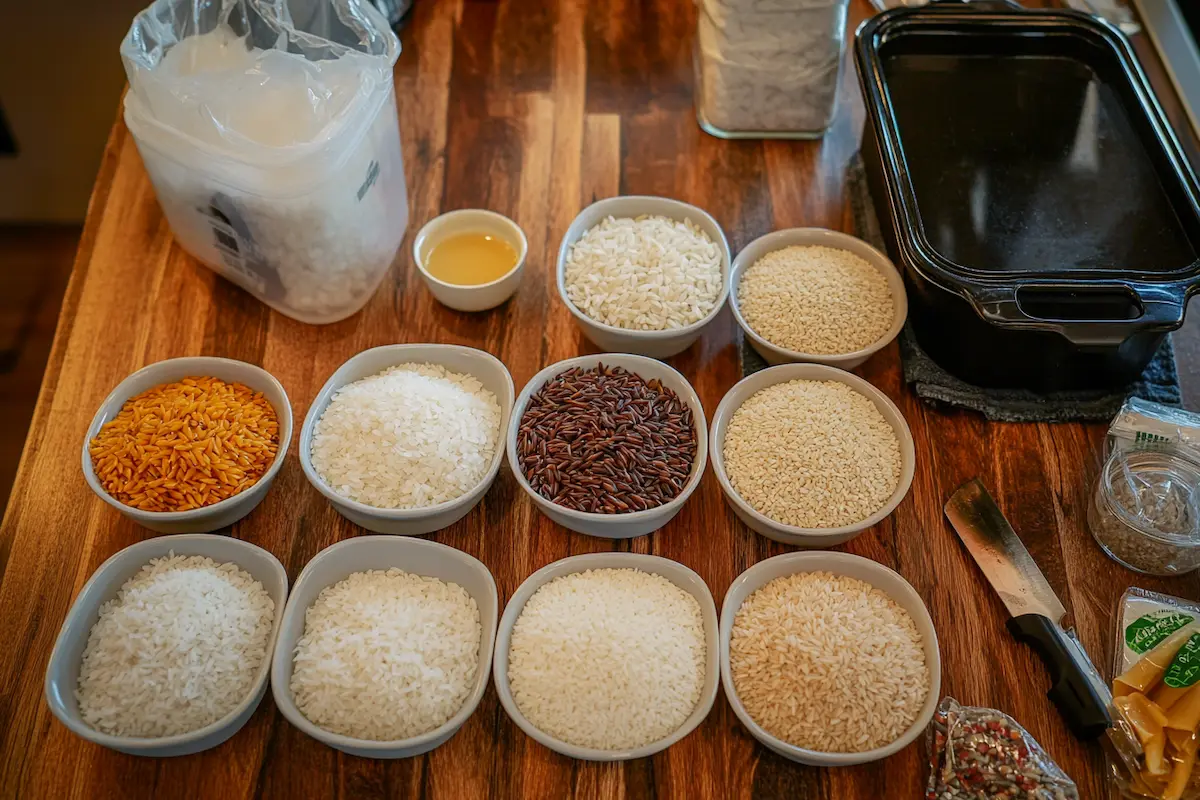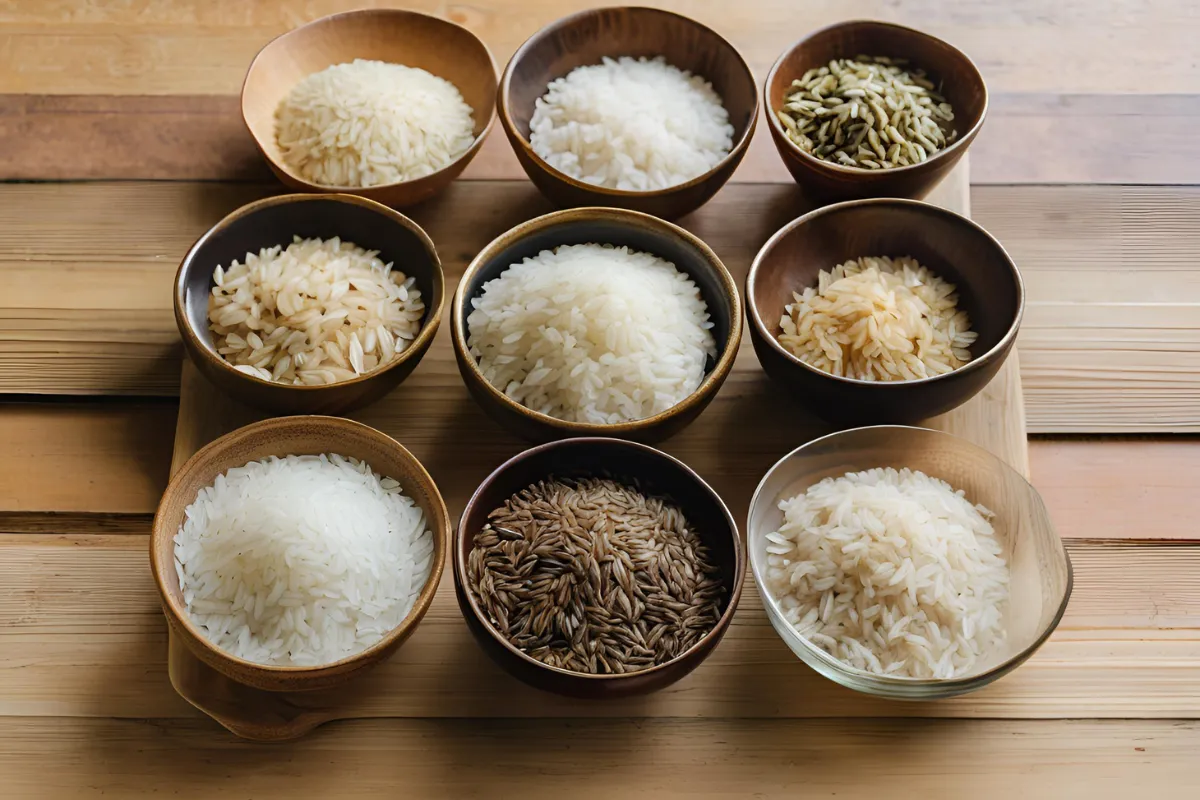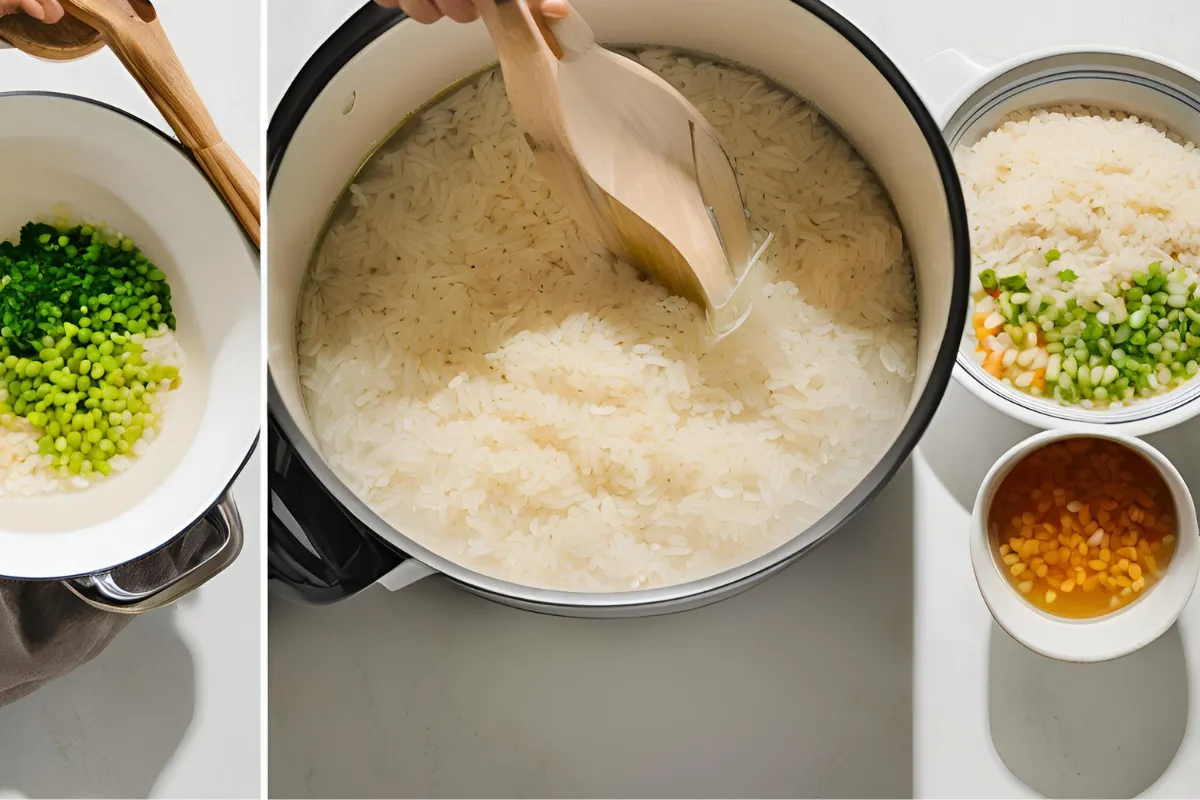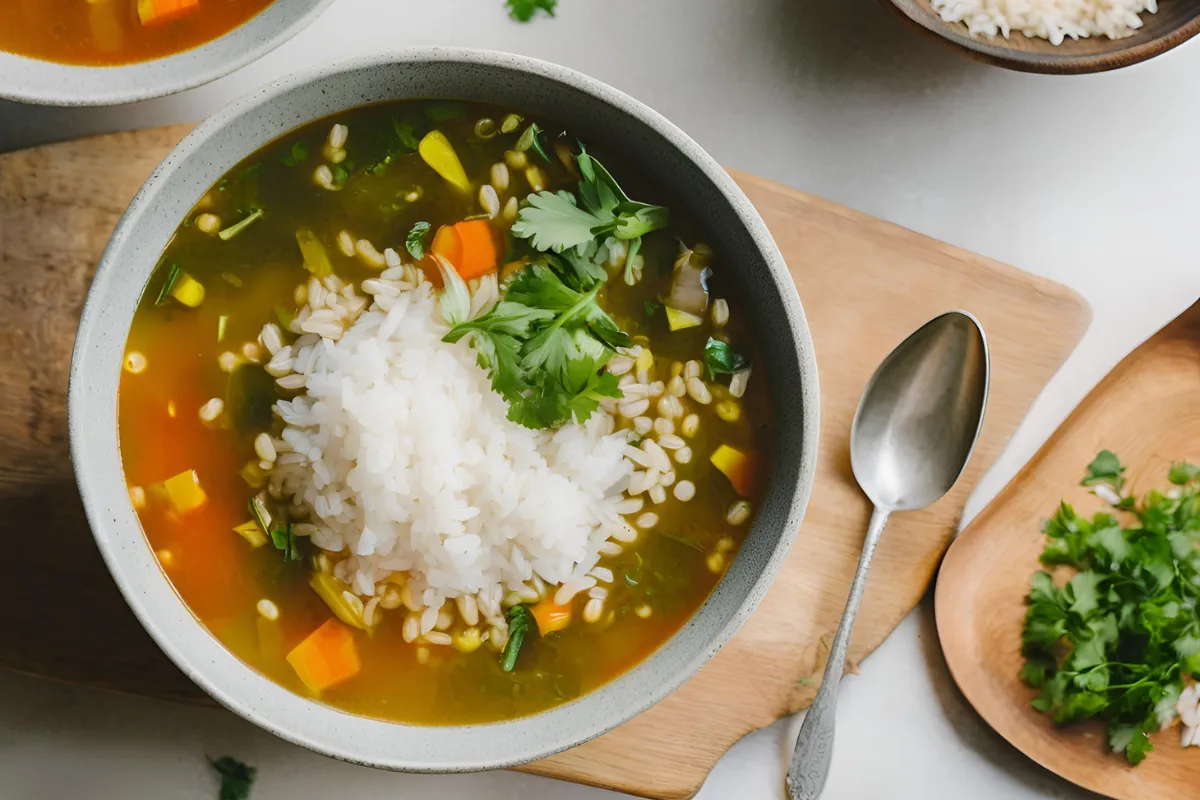Introduction
Soup is one of the most versatile dishes, and what makes it even better is when it’s paired with the perfect rice. The type of rice you choose can dramatically change the texture and flavor of your soup. Whether you’re making a delicate broth-based soup or a hearty, creamy concoction, knowing which type of rice to use can take your recipe from good to great.
In this article, we’ll explore the best rice for soup, from popular options like white rice to aromatic varieties such as jasmine and basmati rice. You’ll discover which rice works best for different types of soups, how to prepare it, and why the right rice choice matters. Let’s dive in and unlock the secrets to the perfect bowl of rice-infused soup!
Overview of Rice for Soup
When it comes to making soup, one of the key ingredients you need to consider is rice. Not only does rice add body to your dish, but it also absorbs the delicious flavors from the broth, transforming a simple soup into a comforting meal. But, with so many different types of rice available, how do you know which one is right for your soup?
The answer lies in understanding the texture, flavor, and consistency you’re aiming for in your soup. Each variety of rice has its unique characteristics, and knowing these differences will help you select the best rice for soup. For instance, white rice is commonly used for lighter, broth-based soups, while brown rice might be the better choice for a hearty, more substantial dish. On the other hand, rice like jasmine and basmati can infuse a delicious fragrance and flavor into your soup.
Not only does the rice choice affect the taste, but it also influences the consistency of the soup. Arborio rice, for example, is often used in creamy soups because of its high starch content, which adds a rich, velvety texture to the liquid. Meanwhile, wild rice adds a chewy texture and a nutty flavor, perfect for more robust, chunky soups.
In this article, we’ll go over the most popular types of rice and help you figure out which one is the best rice, whether you’re looking to create a light, clear broth or a thick, creamy concoction. Let’s start by taking a look at some of the most common rice varieties and their suitability for soup.
Types of Rice and Their Characteristics for Soup
When choosing rice for soup, it’s essential to consider the texture and flavor each variety brings to the dish. Each type of rice has its unique properties, making it more suitable for specific types of soup. Let’s explore the characteristics of the most popular rice varieties and how they can elevate your soup game.
White Rice
Characteristics:
White rice is the most common type used in soups due to its soft, light texture and mild flavor. It absorbs the flavors of the broth well without overpowering them. As it cooks, white rice becomes tender and fluffy, providing a comforting texture in any soup.
Best Soups to Use White Rice In:
White rice works wonderfully in light, clear soups like chicken soup or vegetable broth. It complements brothy soups without soaking up too much liquid, helping to maintain a balanced, clear broth.
Pros and Cons of Using White Rice for Soups:
- Pros: It’s quick to cook, versatile, and absorbs flavors efficiently. The soft texture makes it a great addition to almost any soup.
- Cons: White rice can become too soft if cooked for too long or if too much liquid is absorbed, which might result in a mushy texture. It also lacks the depth of flavor found in other rice types, such as brown or wild rice.
Brown Rice
Characteristics:
Brown rice has a nutty flavor and a chewy texture due to its whole grain nature. Unlike white rice, brown rice retains the bran layer, giving it a firmer texture and more nutritional value.
Best Soups to Use Brown Rice In:
Brown rice is ideal for hearty, filling soups such as hearty vegetable soups or minestrone. It can handle the richness of a thicker broth and adds a substantial bite to the soup.
Pros and Cons of Using Brown Rice for Soups:
- Pros: Brown rice adds a robust, nutty flavor that pairs well with hearty ingredients like beans, vegetables, and meats. It also provides a higher fiber content, making the soup more filling.
- Cons: Brown rice takes longer to cook than white rice and can absorb too much liquid if left too long, making the soup less soupy and more like a stew. Its chewy texture might not be ideal for lighter, more delicate soups.
Jasmine Rice
Characteristics:
Jasmine rice is an aromatic rice known for its fragrant, delicate flavor and slightly sticky texture. Its soft, moist grains add a pleasant fragrance to any dish.
Best Soups to Use Jasmine Rice In:
Jasmine rice shines in Thai soups, coconut milk-based soups, or any broth that benefits from a slight sweetness and floral aroma. It pairs beautifully with soups featuring lemongrass, ginger, and coconut.
Pros and Cons of Using Jasmine Rice for Soups:
- Pros: The aromatic qualities of jasmine rice elevate the overall flavor of Asian soups, especially those with fragrant herbs and spices. Its slight stickiness is also ideal for broth-based soups where the rice stays together in the soup without losing its shape.
- Cons: Jasmine rice tends to be softer than other types, and overcooking it can result in a mushy texture. It might not be the best choice for thicker, hearty soups.
Basmati Rice
Characteristics:
Basmati rice is long-grain and known for its fluffy texture. It is slightly aromatic, though less fragrant than jasmine rice, and has a delicate, subtle flavor.
Best Soups to Use Basmati Rice In:
Basmati rice is excellent in chicken soups, curried soups, or any recipe where you want the rice to remain separate and fluffy, without clumping together.
Pros and Cons of Using Basmati Rice for Soups:
- Pros: The long grain and fluffy texture of basmati rice help it hold its shape in broth, making it ideal for lighter soups. It doesn’t get mushy quickly and provides a nice contrast to thick or creamy soups.
- Cons: While it’s aromatic, basmati’s flavor can sometimes get lost in stronger, heavily spiced broths, so it’s best used in more subtly flavored soups.
Arborio
Characteristics:
Arborio rice is short-grain rice known for its high starch content, which helps create a creamy, velvety texture when cooked.
Best Soups to Use Arborio Rice In:
Arborio rice is commonly used in creamy soups like clam chowder, risotto-based soups, or even tomato soup, where the starch helps thicken the liquid and add richness.
Pros and Cons of Using Arborio Rice for Soups:
- Pros: The starch in Arborio rice gives it a creamy texture, which is perfect for rich, velvety soups. It also absorbs flavors beautifully, making it a great option for creamy broths.
- Cons: Arborio rice can turn overly creamy or even mushy if cooked too long. Its high starch content can also make it too rich for some delicate soups.
Sticky Rice (Glutinous Rice)
Characteristics:
Sticky rice, also known as glutinous rice, has a unique, clumpy, and starchy texture. It’s often used in Asian cuisines, especially in Thai, Lao, and Chinese dishes.
Best Soups to Use Sticky Rice In:
Sticky rice is ideal for Asian soups, especially those with a broth base. It works well in soups like hot and sour soup or any dish where a thicker, starchy consistency is desired.
Pros and Cons of Using Sticky Rice for Soups:
- Pros: The sticky, clumpy texture of this rice adds a satisfying, chewy element to soups, perfect for Asian-inspired recipes. It absorbs the broth without losing shape.
- Cons: Sticky rice can overpower delicate broths due to its dense texture, and it might not work well in lighter or clearer soups.
Wild Rice
Characteristics:
Wild rice isn’t technically rice but rather a seed of an aquatic plant. It has a nutty flavor and chewy texture, often adding an earthy element to soups.
Best Soups to Use Wild Rice In:
Wild rice works best in hearty grain-based soups, like turkey soup, or in vegetable soups where its chewy texture complements chunky ingredients.
Pros and Cons of Using Wild Rice for Soups:
- Pros: Wild rice adds a unique, nutty flavor that pairs well with meaty soups or broths that need a bit of texture and depth. Its chewy consistency is perfect for rustic, hearty dishes.
- Cons: Wild rice can take longer to cook than other types of rice and might not absorb as much broth as you would like. Its hearty texture can be too dense for lighter soups.
How to Cook Rice for Soup
Cooking rice for soup requires some attention to detail. The way you prepare and cook the rice will determine the texture and flavor of your final dish. Whether you choose to cook the rice separately or let it cook directly in the soup, there are specific methods to ensure that your rice is cooked to perfection. Let’s walk through some essential tips and techniques for cooking rice in your soup.
Step-by-Step Guide to Cooking Rice for Soup
First, consider the type of rice you’re using. Different varieties have different cooking times and methods, so knowing how to prepare each one is crucial. For example, white rice cooks quickly and needs little preparation, while brown rice or wild rice requires more time to cook.
If you plan to cook rice separately, rinse it thoroughly before cooking to remove excess starch. This will prevent the rice from becoming too sticky, which could make your soup overly thick. Once rinsed, cook the rice according to its specific instructions (usually on the stove or in a rice cooker). For soup purposes, it’s best to cook the rice until it’s just tender, as it will continue to cook once added to the soup.
Alternatively, you can cook rice directly in the soup. This is a great method when you’re aiming for a more cohesive flavor, as the rice absorbs the broth’s taste. Just be sure to add the rice at the right time—typically when the soup is near its boiling point but not yet fully cooked. This ensures the rice cooks properly without becoming mushy.
Rice Cooking Methods for Soup
- Stove-top Method
The stove-top method is the most common approach for cooking rice in soup. Once your soup is simmering, simply add the uncooked rice. Stir occasionally to prevent sticking and ensure that the rice cooks evenly. Depending on the type of rice, you’ll need to adjust the cooking time. White rice typically takes around 15-20 minutes, while brown rice may take up to 40 minutes. - Pressure Cooker Method
If you’re using a pressure cooker, cooking rice in your soup becomes even more efficient. Add the rice to the soup, close the lid, and cook under high pressure for the time specified for your rice type. This method retains more nutrients, and the rice cooks quickly, making it ideal for busy weeknights. - Rice Cooker Method
A rice cooker can also be used to cook rice before adding it to your soup. Simply cook the rice in the rice cooker as usual and then stir it into the soup just before serving. This method helps maintain a fluffy, non-sticky texture in the rice, perfect for clear broths.
Tips for Avoiding Overcooked or Undercooked Rice in Soup
- Don’t Overcook the Rice: If cooking rice directly in soup, make sure not to cook it for too long. Overcooking can lead to mushy rice that disintegrates into the soup, which might change the texture you’re aiming for. To avoid this, test the rice for doneness about 5 minutes before the soup is done.
- Undercooked Rice: On the other hand, undercooked rice can result in a crunchy texture. If you’re adding the rice directly into the soup, make sure it cooks long enough to soften. If you notice that your rice isn’t done by the time your soup is ready, you can cook it for a few more minutes on the stove, adding a bit more liquid if necessary.
How Much Rice to Add to Soup
The rice-to-soup ratio depends on the type of soup you’re making and the texture you prefer. A good general guideline is to add 1/4 to 1/3 cup of uncooked rice per serving of soup. However, you can adjust this based on your personal preferences.
For clear broths, you might want to add less rice, keeping the texture light and the broth clear. For heartier soups, like minestrone or turkey soup, you may want to add a bit more rice to give the soup a substantial, filling texture.
If your soup becomes too thick as the rice cooks, don’t hesitate to add a bit more liquid to adjust the consistency. Conversely, if you prefer a thicker soup, you can add extra rice or reduce the liquid by cooking the soup uncovered to allow evaporation.
Ultimately, the amount of rice you add will depend on how you like your soup—whether you prefer it with a small amount of rice for a lighter texture or a more substantial soup that feels like a meal.
Best Rice for Different Soup Types
When it comes to choosing the right rice for soup, different types of soups require specific varieties of rice to achieve the desired texture and flavor. Whether you’re making a delicate, clear broth-based soup or a rich, creamy concoction, the rice you choose will significantly impact your soup’s overall character. Let’s take a look at the best rice for various soup types and how each variety enhances the soup.
Rice for Clear Broth-Based Soups
Clear broth-based soups, such as chicken soup or vegetable broth, typically rely on a light and clean texture. For these types of soups, the key is to choose rice that doesn’t cloud the broth or break down too much during cooking.
Best Rice Options: White Rice, Jasmine Rice
- White Rice is a classic choice for clear soups. Its soft texture cooks quickly, and it absorbs the broth’s flavors without becoming too heavy or mushy. It also maintains the clarity of the soup, making it an excellent choice for delicate broths.
- Jasmine Rice is another great option, especially for soups that have an aromatic broth. With its naturally fragrant, floral notes, jasmine rice enhances the flavor profile of your soup, offering a light, delicate texture that complements clear broths. It adds a subtle aroma without overpowering the soup’s clarity or taste.
How Rice Affects Broth Clarity and Texture
When using white rice or jasmine rice in clear soups, these varieties tend to absorb just the right amount of liquid, maintaining the broth’s integrity while adding a soft, tender bite. These types of rice won’t cloud the broth, which is important for soups like chicken noodle or miso soup, where the visual clarity is key.
Rice for Creamy Soups
Creamy soups like chowders, cream-based vegetable soups, and bisques require rice that contributes a smooth, velvety texture. The rice used in these soups should not only soften but also release starch to thicken the liquid, creating a more substantial, rich consistency.
Best Rice Options: Arborio Rice, White Rice
- Arborio Rice is the quintessential choice for creamy soups. This short-grain rice is high in starch, which, when released during cooking, creates a luscious, creamy texture perfect for soups like creamy mushroom or potato chowder. It’s also the rice of choice for risotto, which is similar in texture to these creamy soups.
- White Rice, though not as starchy as Arborio, still adds a mild creaminess when cooked in a creamy soup. It will absorb the cream-based broth and soften beautifully, though it won’t thicken the soup as Arborio does. If you’re looking for a lighter, less dense cream soup, white rice is a good alternative.
How Rice Creates a Creamy Texture in Soups
When Arborio rice is used, it releases its starch into the broth as it cooks, giving the soup a naturally creamy consistency. This makes it ideal for thick, hearty soups with a rich, smooth mouthfeel. White rice, though not as starchy, still blends well into cream-based soups, softening to add just the right texture without dominating the flavor.
Rice for Hearty, Chunky Soups
For soups that are filled with vegetables, meats, or legumes, such as minestrone or turkey soup, the rice should complement the hearty ingredients without overwhelming them. The rice should have a chewy texture that holds its shape and adds substance to the dish.
Best Rice Options: Brown Rice, Wild Rice
- Brown Rice brings a nutty flavor and chewy texture to chunky soups. Unlike white rice, which cooks up soft and tender, brown rice maintains its integrity even when simmered for longer periods. It’s great for hearty soups because it adds depth without turning mushy.
- Wild Rice is another excellent choice for chunky soups. It’s not technically rice but a type of aquatic grass, and it has a firmer, chewier texture that makes it stand out in hearty soups. Wild rice also imparts a slightly nutty, earthy flavor, making it ideal
- soups like turkey wild rice soup or any soup with earthy vegetables.
How Rice Complements the Texture of Chunky Soups
Brown rice and wild rice both work well in soups with lots of vegetables and chunks of meat, as they hold up during long cooking times and add a satisfying bite. These rice varieties provide a more substantial mouthfeel, enhancing the texture of the soup and ensuring it feels hearty and filling.
Rice for Spicy or Curry-Based Soups
For spicy or curry-based soups, the rice should complement the rich, aromatic flavors of the broth without overshadowing them. Aromatic rice varieties work especially well in these types of soups, as they help to absorb and enhance the complex flavors of the spices.
Best Rice Options: Basmati Rice, Jasmine Rice
- Basmati Rice is known for its long grains and fragrant, slightly nutty flavor. It’s a classic choice for Indian or Thai soups, such as curry-based or coconut milk-based soups. Basmati rice absorbs the spices in the broth without becoming too sticky, making it a perfect accompaniment to dishes like chicken tikka masala soup or Thai coconut curry soup.
- Jasmine Rice is another aromatic rice variety that complements curry-based soups beautifully. It has a fragrant, floral aroma that pairs well with the complex spices in dishes like Thai tom kha gai (coconut soup) or Indian dal. Jasmine rice absorbs the broth well while maintaining its fluffiness, adding an extra layer of flavor to the soup.
How Aromatic Rice Enhances the Flavor Profile of Curry-Based Soups
Both Basmati and jasmine rice have subtle, aromatic qualities that elevate the flavor profile of curry-based soups. The rice absorbs the spices in the broth, adding a delicate fragrance and rich texture that complements the bold, spicy flavors.
Rice for Asian Soups
In many Asian soups, rice plays a crucial role in enhancing the overall texture and flavor. From Chinese to Thai to Japanese dishes, the rice variety chosen will influence the soup’s consistency and the way the rice integrates with the broth.
Best Rice Options: Sticky Rice, Jasmine Rice
- Sticky Rice (Glutinous Rice) is a staple in many Asian soups. Known for its clumpy, starchy texture, sticky rice absorbs the broth beautifully while maintaining its chewy, satisfying texture. It’s perfect for soup dishes like Thai tom yum or Chinese herbal soups, where the rice adds substance to the broth.
- Jasmine Rice, often used in Southeast Asian cuisine, adds a light, fragrant flavor to soups. Its delicate texture and subtle aroma enhance the soup without overwhelming the other ingredients, making it ideal for soups like Vietnamese pho or Thai curry soups.
How Rice Varieties Like Sticky Rice and Jasmine Enhance the Texture of Popular Asian Soups
Sticky rice helps create a thicker, heartier texture in Asian soups, making it more filling and satisfying. On the other hand, jasmine rice lends its delicate fragrance and slightly fluffy texture, making it the perfect companion for soups with lighter broths or aromatic herbs.
FAQs Section
Can I use brown rice instead of white rice for soup?
Yes, you can substitute brown rice for white rice in most soups. Brown rice will add a nuttier flavor and a chewier texture, which is ideal for heartier, more robust soups like minestrone or vegetable soups. However, keep in mind that brown rice takes longer to cook than white rice, so you may need to adjust the cooking time.
Can you add uncooked rice directly to soup?
Yes, you can add uncooked rice directly to soup, but timing is crucial. Add the rice once the soup is simmering, and make sure to give it enough time to cook through. Keep an eye on the texture and adjust the liquid as necessary since rice absorbs broth while cooking.
How do I prevent rice from becoming too mushy in soup?
To prevent rice from becoming mushy, avoid overcooking it in the soup. If you’re adding rice directly to the soup, test for doneness about five minutes before the soup is finished cooking. If cooking separately, rinse the rice to remove excess starch, which can cause it to become sticky.
Can I use wild rice for creamy soups?
While wild rice can be used in creamy soups, it’s better suited for heartier, chunky soups due to its chewy texture. For a smooth, velvety consistency, it’s recommended to use Arborio rice or white rice instead.
What rice doesn’t get mushy in soup?
Basmati and wild rice tend to hold their shape well in soup. They absorb flavors without breaking down into mush, making them perfect for soups where you want the rice to maintain its distinct texture.
What rice stays firm in soup?
Brown rice and wild rice are both excellent choices if you want rice that stays firm in soup. These rice varieties have a firmer texture and won’t break down or become overly soft during longer cooking times.
Is basmati or jasmine rice better in soup?
Both Basmati and jasmine rice are great for soup, but they serve different purposes. Basmati rice is ideal for curry-based or savory soups due to its fluffy texture and subtle nutty flavor, while jasmine rice works best in lighter, aromatic broths like Thai soups.
How do you keep rice from getting mushy in soup?
To keep rice from getting mushy, consider adding it at the right stage of cooking. Avoid overcooking by testing rice for doneness before the soup is finished. Also, using rice with a firmer texture, like wild rice or brown rice, can help it hold up better.
Conclusion
Choosing the best rice for your soup is crucial to achieving the desired texture and flavor. Whether you’re making a delicate broth-based soup or a rich creamy soup, the right rice can enhance the dish and bring everything together. White rice and jasmine rice are versatile options that work well in most soups, providing a light texture and subtle flavor. For heartier soups, brown rice and wild rice are excellent choices, offering a chewy bite and nutty flavor that complements chunky ingredients.
The most important takeaway is that different types of rice suit different soups, so don’t hesitate to experiment and discover what works best for your favorite recipes. Don’t be afraid to mix it up and try new variations—after all, cooking is all about creativity! With the right rice, your soups will be hearty, flavorful, and satisfying, making every spoonful an enjoyable experience.




